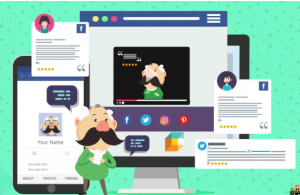In the digital age, where consumers are inundated with marketing messages, businesses face the challenge of standing out in a crowded marketplace. One of the most effective strategies to overcome this challenge is harnessing the power of user-generated content (UGC). This article delves into what UGC is, its significance in eCommerce marketing, and how brands can effectively incorporate it to enhance engagement, build trust, and drive sales.

Understanding User-Generated Content (UGC)
User-generated content refers to any form of content- text, images, videos, reviews, or social media posts- created by customers or users rather than by the brand itself. This content is often seen as more authentic and relatable because it reflects real experiences and opinions. According to a report by Stackla, 79% of people say user-generated content highly impacts their purchasing decisions, demonstrating its potent influence in the eCommerce landscape.
The Rise of UGC in eCommerce
The rise of social media and online communities has significantly contributed to the proliferation of UGC. Platforms like Instagram, Facebook, and TikTok allow users to share their experiences with products, leading to organic word-of-mouth marketing. A survey by Nosto found that 60% of consumers find user-generated content to be the most authentic form of advertising, underscoring its effectiveness in capturing consumer attention.
As eCommerce continues to grow- expected to reach $6.3 trillion in 2024 according to eMarketer- brands are increasingly turning to UGC to connect with their audiences on a deeper level.
The Benefits of UGC in eCommerce Marketing
1. Building Trust and Credibility
One of the primary benefits of UGC is its ability to build trust among consumers. When potential customers see real people using and enjoying a product, they are more likely to perceive the brand as trustworthy. In fact, a study by Nielsen found that 92% of consumers trust recommendations from friends and family more than any other type of advertising.
Furthermore, showcasing UGC can mitigate skepticism often associated with traditional advertising. By featuring reviews, testimonials, and photos from satisfied customers, brands can create a sense of community and authenticity that resonates with prospective buyers.
2. Enhancing Engagement
UGC fosters engagement and interaction between brands and their customers. By encouraging customers to share their experiences, brands can create a more dynamic and interactive marketing environment. A report from Yotpo found that customers who engage with UGC are 4.6 times more likely to make a purchase than those who do not, highlighting the direct correlation between UGC and increased sales.
Brands can harness this engagement by creating campaigns that invite customers to share their content. For example, hosting contests or challenges that reward users for sharing their experiences can significantly boost participation and brand visibility.
3. Cost-Effective Marketing
Creating high-quality content can be time-consuming and expensive. However, UGC offers a cost-effective solution. Brands can leverage content created by their customers without the need for significant marketing budgets. According to a report from HubSpot, UGC costs 50% less than traditional marketing and generates 6.9 times higher engagement rates.
By curating and showcasing UGC, brands can maintain an active online presence without overextending their marketing resources. This cost-effectiveness is especially beneficial for small businesses looking to compete with larger competitors.
4. SEO Benefits
User-generated content can also positively impact a brand’s search engine optimization (SEO) efforts. Fresh, relevant content is crucial for improving search engine rankings, and UGC can provide a steady stream of new material. For instance, customer reviews and testimonials contribute valuable keywords and phrases that can enhance a website’s visibility.
Research from BrightLocal indicates that 87% of consumers read online reviews for local businesses, emphasizing the importance of user-generated reviews in attracting new customers. By integrating UGC into their websites, brands can not only improve SEO but also create a more engaging shopping experience.
5. Social Proof
Social proof is a psychological phenomenon where individuals rely on the behavior and opinions of others to guide their decisions. UGC acts as a form of social proof, validating a product’s quality and effectiveness through the experiences of others. When potential customers see others enjoying a product, they are more inclined to make a purchase.
According to a study by CrowdRiff, 56% of consumers stated that they trust UGC more than brand-created content, showcasing the powerful role UGC plays in shaping consumer perceptions. Brands can strategically display UGC on their websites and social media channels to leverage this social proof effectively.
Strategies for Incorporating UGC in eCommerce Marketing

1. Create Dedicated Hashtags
Brands can encourage customers to share their experiences by creating unique, branded hashtags. This makes it easier to track and curate user-generated content across social media platforms. By promoting these hashtags in marketing materials, brands can motivate customers to share their experiences, increasing visibility and engagement.
2. Feature UGC on Product Pages
Incorporating UGC directly on product pages can significantly enhance the shopping experience. By displaying customer reviews, images, and videos, brands can provide potential buyers with valuable insights into the product’s performance and usability. This not only boosts trust but also helps consumers feel more confident in their purchasing decisions.
3. Run Contests and Campaigns
Running contests that incentivize customers to share their content is an effective way to generate UGC. For example, a clothing brand could encourage customers to post photos wearing their products for a chance to win a gift card. This approach not only generates a wealth of content but also fosters community engagement.
4. Collaborate with Influencers
Partnering with influencers can amplify the reach of UGC. By collaborating with individuals who align with the brand’s values, companies can tap into new audiences and encourage authentic content creation. Influencers can help spread the word about specific campaigns, further driving UGC.
5. Create a UGC Gallery
Establishing a dedicated section on a website for UGC can showcase customer contributions and encourage others to participate. This gallery can include photos, videos, and testimonials, creating a sense of community and pride among customers.
Challenges of UGC in eCommerce Marketing
While UGC presents numerous benefits, brands must also navigate the challenges associated with it.
1. Quality Control
Ensuring the quality of UGC can be difficult, as brands have limited control over what customers share. However, brands can mitigate this challenge by curating content and encouraging customers to share high-quality images and videos.
2. Legal Considerations
Brands must be cautious about copyright and ownership issues when using UGC. It’s essential to obtain permission from users before featuring their content in marketing materials. Establishing clear guidelines and providing credit to the original creators can help navigate these legal considerations.
3. Negative Content
While UGC can be overwhelmingly positive, brands must be prepared to address negative feedback and reviews. Having a strategy in place to respond to criticism and engage with dissatisfied customers can help mitigate potential damage to the brand’s reputation.
TrueGether: A Platform for User-Generated Content Success

TrueGether, one of the best eBay alternatives, is an innovative platform that empowers sellers to leverage user-generated content effectively. With over 10,000 businesses already powered by TrueGether, the platform facilitates reaching millions of shoppers through AI-empowered campaigns. TrueGether makes it easy for sellers to manage, promote, and grow their businesses without any fees, allowing them to offer the best prices to consumers.
Sellers can effortlessly add products or upload inventory files, and TrueGether will automatically optimize listings and decide on suitable advertising channels. This automation allows sellers to focus on other important aspects of their businesses while still achieving significant results. TrueGether supports various product categories, ranging from electronics to fashion, enabling sellers to find their niche and thrive in the competitive eCommerce landscape.
By providing a no-fee environment, TrueGether ensures that sellers retain 100% of their sales, fostering an ecosystem where they can flourish. With features like PayPal Seller Protection Guarantee and easy payment processing through PayPal and Amazon Payments, sellers can feel secure in their transactions while focusing on increasing their online sales.
Wrapping Up
The power of user-generated content in e-commerce marketing cannot be underestimated. By leveraging the authenticity and engagement that UGC offers, brands can build trust, enhance customer loyalty, and ultimately drive sales. As eCommerce continues to evolve, integrating UGC into marketing strategies will remain a vital component for brands looking to connect with consumers on a deeper level.
By fostering a community of satisfied customers who actively share their experiences, brands can not only increase their visibility but also cultivate a strong brand identity that resonates with today’s consumers. In a world where authenticity is paramount, user-generated content stands out as a key player in shaping the future of e-commerce marketing.